The African wood owls are particularly vocal in our neighbourhood. But apart from sometimes seeing a dark silhouette at dusk or a flash of flying feathers illuminated by a street light at night, we seldom catch even a glimpse of them.
African wood owls (Strix woodfordii) are very chatty, especially at dusk and into the night, and so we are often aware of their presence despite them mostly not being visible. Their call is the stereotypical “whoo” and also they duet in pairs with an almost dovelike cadence. There are several recordings of their calls here: https://www.xeno-canto.org/species/Strix-woodfordii
Recently one evening after two birds flew into a nearby tree, thinking they may well be owls I reflexively called “whoo” in the best owl enunciation I could muster. Much to my amazement, quick as a flash came back a response, a loud “whoo”. After a brief call and response between me and owl, the owls took over in their more complicated and nuanced duet, which Roberts represents as “Who-who, Who-who-who are-you” with the female calling at a slightly higher pitch than the male, and outclassed I lapsed into silence – much to the relief of our two dogs.
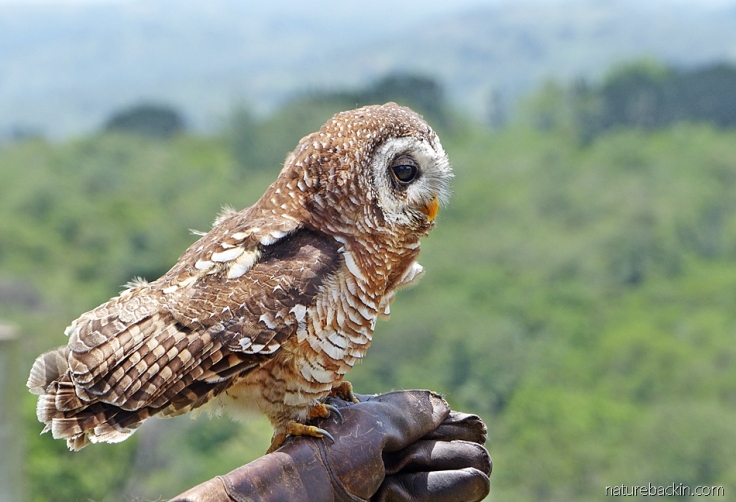
Because of the nocturnal habits of the African wood owls the only photos I have of wood owls were taken at the African Raptor Centre in KwaZulu-Natal, South Africa. This picture of the free-flying display bird perched on the glove of the handler shows the petite stature of the African wood owl
Wood owls are relatively small, weighing in at about 250 g (males) and 335 g (females), and being 30-36 cm in length. To most human eyes they are undeniably cute. As their name implies, their natural habitat is forest and woodland and in some regions, such as ours, they have adapted to exotic plantations and well-treed gardens.
I was intrigued that the scientific name for the African wood owl – Strix woodfordii – also includes “wood” in the name. The reason is that it is named for Colonel E.J.A. Woodford (1761–1835), a British soldier of the Napoleonic Wars who was also a naturalist, and so the “wood” in its scientific name is coincidental. Interestingly, in isiZulu the male and female African wood owls are named differently – uMabhengwane (female) and uNobathekeli (male).
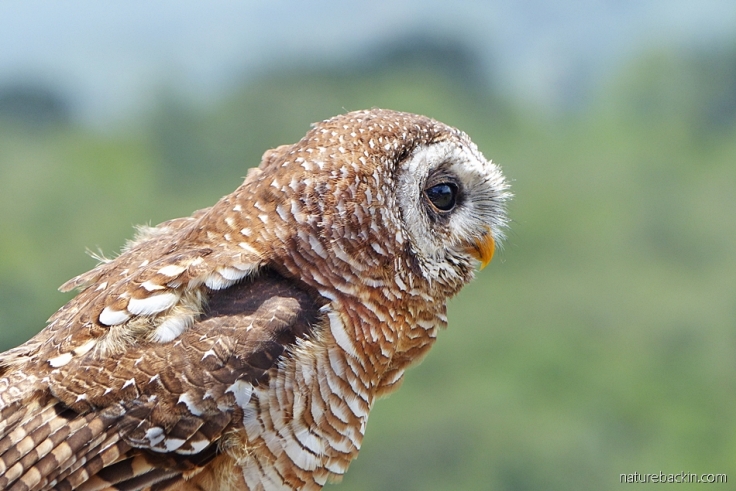
The African wood owl at the African Raptor Centre during its free-flying display
Adult African wood owls live in territorial pairs. They hunt usually from low perches but they may also hawk insects or bats in flight, or glean insects off foliage. They prey mostly on insects and small birds and nestlings, and they also eat centipedes, rodents and other small mammals, frogs and small reptiles sometimes including snakes.
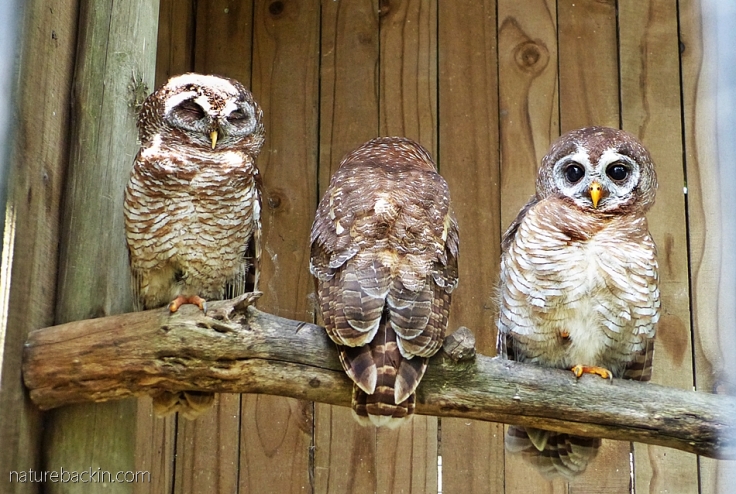
Three rescued African wood owls who are permanent residents at the African Raptor Centre. As far as I remember the bird on the left is blind
The other species of owl that we hear calling in our garden, although not as often as the wood owl, is the spotted eagle-owl (Bubo africanus). On some nights though we have heard both the duet of the wood owls and the duet of the eagle-owls, and one night most surprisingly we glimpsed all four owls flitting into the same tree.
The male spotted eagle-owl often initiates the duet with a two-note call to which the female responds with a deeper three-note call. Recordings can be heard here https://www.xeno-canto.org/species/Bubo-africanus. Some of the recordings are better than others at capturing the duet.
At an average weight of 700 g and being 43-47 cm in length, the spotted eagle-owl is quite a bit heavier and longer than the wood owl. Unlike the wood owl the spotted eagle-owl has noticeable ear tufts.
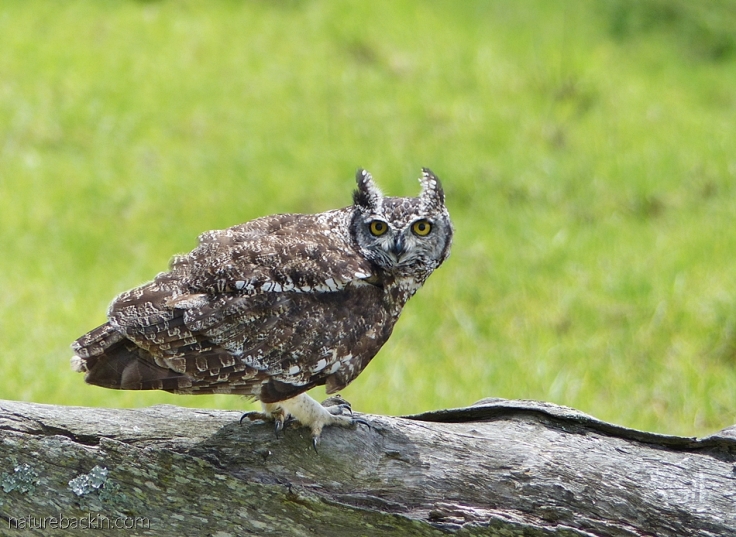
A spotted eagle-owl, looking almost feline, during its flight display at the African Raptor Centre
Whereas the African wood owl is dependent on well-wooded habitats, the spotted eagle-owl can survive in a variety of habitats, from desert to scrubland, grassland and forest margins, and some have adapted to urban environments too.
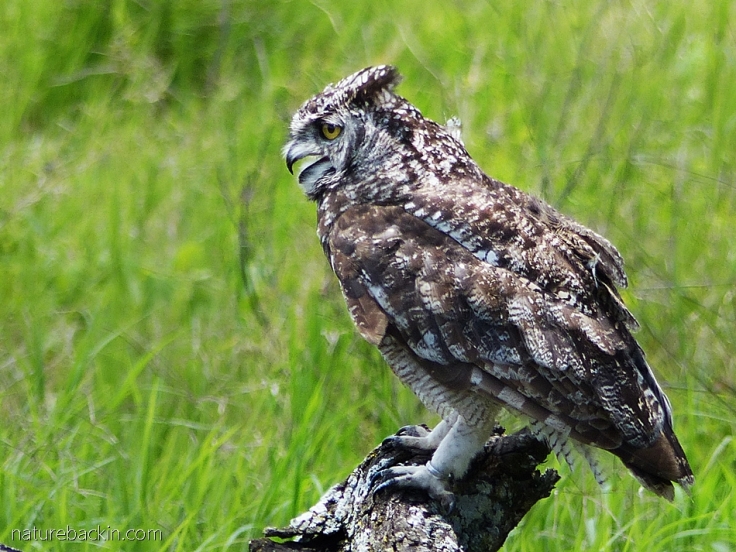
The spotted eagle-owl showing something of its power
Spotted eagle-owls mostly hunt at night, commonly swooping down on roosting animals. Prey includes small mammals such as hares and bushbabies, birds, bats, insects, spiders, snails, crabs and millipedes. They are also known to take poisonous snakes and will also feed on carrion.
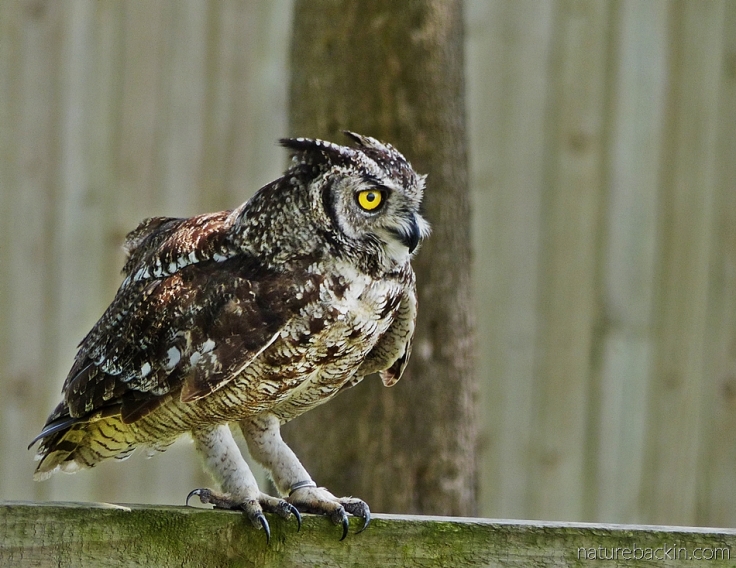
A spotted eagle-owl in its enclosure at the African Raptor Centre
Breeding pairs of spotted eagle-owls often nest on the ground. According to Roberts, in a study of 269 nests, 61% were on the ground, 26% in trees, and 11% on buildings. The nest is basically a scrape on the ground but is usually concealed in some way such as by vegetation, rocks or debris or because it is on a ledge or in a hollow or gulley. Unsurprisingly for mostly ground-nesting birds, the owls can defend their young aggressively, even threatening and attacking an intruder with wings out and bill snapping. As another strategy, they may perform distraction displays such as flopping about on the ground while emitting mewing calls (Roberts).

I took this picture, from an upstairs window of an adjacent house, of a spotted eagle-owl at dusk on a roof in a seaside town, Onrus, in the Western Cape
Threats to the spotted eagle-owl include interference from humans, for example with young birds still too young to fly being removed from the vicinity of nests with people mistakenly believing they are in trouble. Spotted eagle-owls have a high casualty rate from vehicle collisions and also they get entangled in barbed wire fences. Drowning is another hazard recorded by Roberts.
All raptors, including owls, are affected by rat poisons that they commonly ingest from eating poisoned prey. The effect is usually fatal, but lower doses can result in significant health issues that ultimately lead to death. For my earlier post on raptors and rat poison see here.
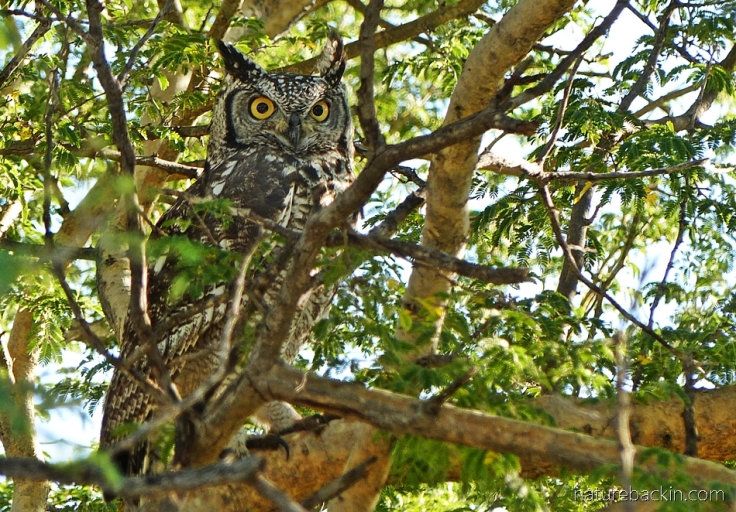
By way of comparison, this is the larger Cape eagle-owl, which I photographed early one morning in the Central Kalahari Game Reserve in Botswana
The Cape eagle-owl with the male’s weight averaging 1.0 kg, and the female 1.2 kg, and being about 50 cm in length, is larger than the spotted eagle-owl. It is less common than the spotted eagle-owl. The majority of its prey comprises small mammals, including hyraxes, cane rats and hares, although it will also hunt other species, including bats and many species of birds.
For information about a specialised Owl Rescue Centre in North West Province in South Africa see http://www.owlrescuecentre.org.za/Home/. Projects run by the centre include not only the rescue and rehabilitation of owls and providing sanctuary for those that cannot be released, but also a rat trapping service and an ongoing plastic recycling project turning plastic waste into owl houses, bat houses and bee hives. (See also on Facebook at https://www.facebook.com/OwlRescueCentre/).
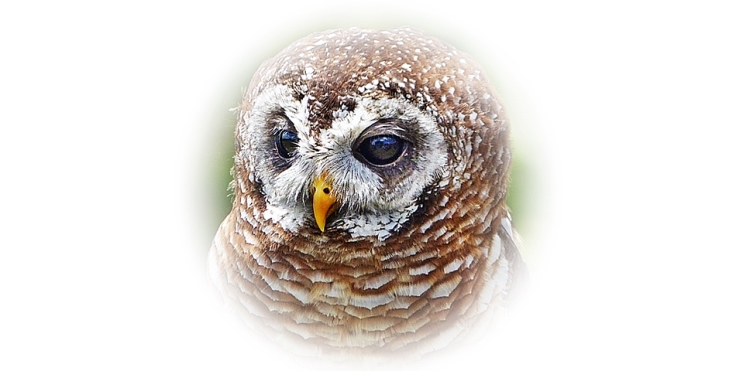
Sources:
Molepo, Dikobe & The Rural Citizen Science Birding Project, Team Finches (Tshegofatso Motene, Dipolelo Mahlo, Lizzy Masinga, Percy Mafumane and Tsietsi Moraba). [n.d.] African wood owl. South African Biodiversity Institute (SANBI). https://www.sanbi.org/animal-of-the-week/african-wood-owl/; Roberts VII Multimedia PC Edition. 1997-2016 Southern African Birding. For details go to http://www.sabirding.co.za/roberts7/portal.html
Posted by Carol

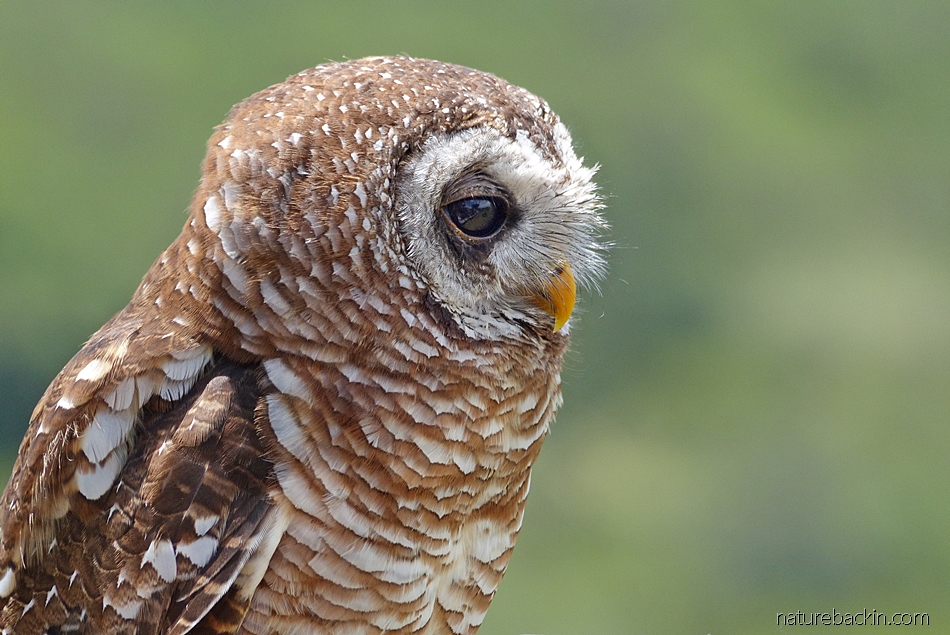







March 3, 2020 at 12:11 am
Such a beautiful post, as usual! Owls are so amazing..I love catching the sight of one. If you ever are interested, Jane Yolen’s picture book Owl Moon is a thoughtful winter owl experiential book . Great for kids and adults. Thank you so much once again for your postings !!!
LikeLiked by 2 people
March 6, 2020 at 8:11 pm
Thank you very much. And thanks for pointing me to Jane Yolen’s book. I have just looked at it online – it is so sympathetically written and the illustrations are brilliant.
LikeLiked by 2 people
March 1, 2020 at 9:20 pm
Fine-looking birds. Owls are really remarkable in so many ways. I often hear tawny owls at night and their cries are the soul of our woodlands.
LikeLiked by 2 people
March 6, 2020 at 8:03 pm
Thanks Adele. I have just looked up your handsome tawny owl and listened to recordings of the calls of both the male and the female (and a duet). I like the way you describe their cries as the soul of your woodlands.
LikeLiked by 1 person
March 1, 2020 at 5:25 pm
Thank you for another fascinating post. I love hearing the call of the owl at night at Hogsback
LikeLiked by 2 people
March 6, 2020 at 7:57 pm
Thanks Mariss. I imagine that the Hogsback must be a fantastic region for owls.
LikeLiked by 1 person
March 1, 2020 at 4:29 am
Great photos as always. Owls are such fascinating birds with their intense stares and heads on swivels. My first thought when I saw the owl on the roof was of a kid trick or treating! Something about the pose.
LikeLiked by 2 people
March 6, 2020 at 7:42 pm
Thanks Graham. I have looked back at the pic of the owl on the roof and I see what you mean about the pose 🙂
LikeLiked by 1 person
February 29, 2020 at 5:29 pm
Could anything be more beautiful than an owl! Whoo-hoo wood owls.
LikeLiked by 2 people
February 29, 2020 at 7:47 pm
Well said 🙂
LikeLiked by 1 person
February 29, 2020 at 3:44 am
I am so envious that you have a pair of wood owls frequenting your property, Carol! I had great fun looking for wood owls at night when last we visited Swadini, and I became thoroughly enchanted with them ever since – they really are the closest thing we have to the owls in the children’s fairy tale books.
Here in Garsfontein we regularly see a pair of spotted eagle owls, and they even brooded and raised a threesome of chicks in the gutters of the local library last year, to our great pleasure!
LikeLiked by 2 people
February 29, 2020 at 7:41 pm
I agree about the enchanting wood owls. How great that the spotted eagle-owls were able to raise three chicks near your local library last year. Encouraging to hear such good news.
LikeLiked by 1 person
February 28, 2020 at 7:19 pm
What a spectacular array of animals, wonderful photographs!
LikeLiked by 2 people
February 28, 2020 at 7:22 pm
Thanks very much Isabel. The African wood owl is a particular favourite of mine.
LikeLike
February 28, 2020 at 5:50 pm
These are lovely little owls to learn about, I enjoyed hearing their calls as well. As always, great post and photos, Carol!
LikeLiked by 2 people
February 28, 2020 at 7:21 pm
Thanks very much Eliza and I am glad that you listened to the calls. It is easier photographing captive birds than wild birds. I feel sorry for the birds that cannot be released but they are well cared for in well thought out and spotlessly clean enclosures.
LikeLiked by 1 person
February 28, 2020 at 10:06 pm
And they’re ambassadors for wildlife education. A better alternative to euthanasia, methinks.
LikeLiked by 1 person
February 28, 2020 at 4:24 pm
Like most people, I have occasionally heard owls at night, but have never seen one
in person. They are so beautiful and fascinating!
LikeLiked by 2 people
February 28, 2020 at 7:19 pm
Indeed they are beautiful. Perhaps that they are so hard to see adds to the fascination.
LikeLiked by 1 person
February 28, 2020 at 9:31 pm
Yes, I think that is the case.
LikeLike
February 28, 2020 at 4:20 pm
Thanks for your informative share and never knew so much about owls. The pictures are awesome.
LikeLiked by 2 people
February 28, 2020 at 7:17 pm
Thanks very much Kamal 🙂
LikeLike
February 29, 2020 at 3:28 am
Welcome 😊😊😊 Carol
LikeLiked by 1 person
February 28, 2020 at 3:21 pm
Enjoyed this post – Owls are intriguing
LikeLiked by 1 person
February 28, 2020 at 7:17 pm
Thank you. Yes, owls are particularly intriguing.
LikeLiked by 1 person
February 28, 2020 at 3:15 pm
Owls … such special birds! We used to see the shadowy owls fly silently through the suburbs many years ago and even had one choose an Erythrina in our garden to perch in during the day – so high up an well camouflaged that it was nigh impossible to photograph it. I fear rat poisons have had an effect on the owl population here for we have neither seen nor heard one for years.
LikeLiked by 1 person
February 28, 2020 at 7:13 pm
They are so special. That is so sad to hear of the apparent demise of owls in your area. Rat poison is likely the culprit. So awful, and so ironic that the creatures that predate on rats and so are beneficial to humans in that respect are killed, which apart from creating appalling suffering, results in an absence of owls and other raptors that compounds the problem of unwanted rats.
LikeLike
February 28, 2020 at 3:07 pm
OMG. Owls are sooo special to me. We don’t see them very often here in Colorado, but when we camp, we can sometimes here them hooting away. Every now and then we can feel the draft of their wings over the tent in search of prey – it’s fantastic!!
LikeLiked by 1 person
February 28, 2020 at 3:07 pm
hear – not here. lol
LikeLiked by 1 person
February 28, 2020 at 7:08 pm
🙂
LikeLiked by 1 person
February 28, 2020 at 7:07 pm
How fantastic indeed to feel the draft from the wings of the owl flying over! Even when you can’t feel them so directly, owls definitely have a strong presence.
LikeLiked by 1 person
February 28, 2020 at 2:23 pm
Well, it’s good to know you’re nearly fluent in African Wood Owl-ese – but do you know what you are saying? These are magnificent photos to accompany your – as usual – fascinating post. We hear Little Owls a lot round here – but as for seeing them? Never. We do better with Barn owls, which tend to veer across our path on country roads at dusk and dawn. It is quite extraordinary how many varieties there are world wide.
LikeLiked by 1 person
February 28, 2020 at 7:03 pm
Well I confess I don’t know what I am saying, but I thought it might equate to a friendly “I see you”, but for all I know the owl might be saying “watch out” or something even less friendly!
I just looked up the Little Owl and they really are little. I was curious to see that they were introduced to the UK in the 19th C.
Barn owls also occur here South Africa, but I am not aware of any in our neighbourhood.
You inspired me to look up owls worldwide – fascinating!
LikeLike